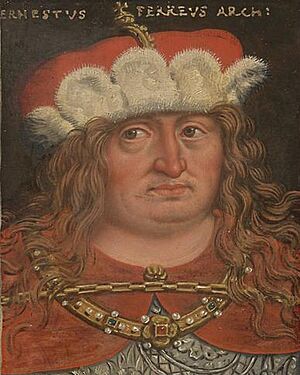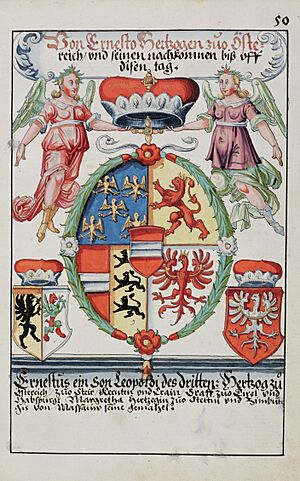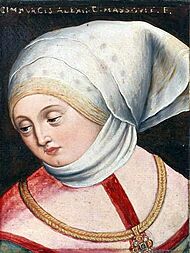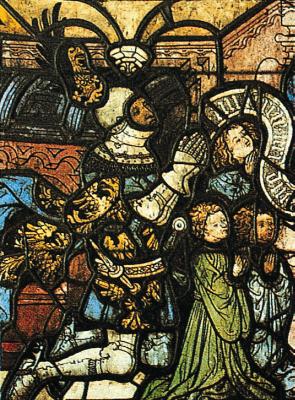Ernest, Duke of Austria facts for kids
Quick facts for kids Ernest I |
|
|---|---|
| Duke of Austria | |

Portrait by Anton Boys, c. 1580
|
|
| Duke of Styria, Carinthia and Carniola | |
| Reign | 15 July 1406 – 10 June 1424 |
| Predecessor | William |
| Successor | Frederick V and Albert VI |
| Born | 1377 Bruck an der Mur, Duchy of Styria |
| Died | 10 June 1424 Bruck an der Mur, Duchy of Styria |
| Spouse | Margaret of Pomerania Cymburgis of Masovia |
| Issue | Frederick III, Holy Roman Emperor Margaret of Austria Albert VI, Archduke of Austria Alexander of Austria Rudolf of Austria Catherine of Austria Leopold of Austria Anna of Austria Ernest of Austria |
| House | Habsburg |
| Father | Leopold III, Duke of Austria |
| Mother | Viridis Visconti |
Ernest the Iron (German: Ernst der Eiserne; 1377 – 10 June 1424) was an important ruler from the House of Habsburg. He governed the duchies of Styria, Carinthia, and Carniola. These areas are now parts of modern-day Austria and Slovenia. He ruled these lands from 1406 until his death. From 1411, he became the leader of the Leopoldian line of the Habsburg family.
Contents
Ernest's Early Life and Family Background
Ernest was born in Bruck an der Mur in Styria in 1377. He was the third son of Duke Leopold III of Austria and his wife, Viridis Visconti. Viridis was the daughter of Bernabò Visconti, a powerful lord from Milan.
Shortly after Ernest was born, his father Leopold III and his uncle Albert III divided the Habsburg family lands. This happened through an agreement called the 1379 Treaty of Neuberg. Albert III and his family line, called the Albertinian line, would rule over the main Duchy of Austria.
The Leopoldian Line and Their Lands
Ernest's family, the Leopoldian line, received other important territories. These included the Inner Austrian states of Styria, Carinthia, and Carniola. They also gained the March of Istria, Tyrol, and other lands further west.
In 1386, Ernest's father, Leopold III, died in the Battle of Sempach. After his father's death, young Ernest and his brothers, William, Leopold IV, and Frederick IV, were cared for by their uncle Albert III.
Becoming a Ruler and Duke
In 1401, Ernest joined King Rupert of Germany on a military trip to Italy. This was an important experience for him.
When his older brother William died in 1406, the remaining three brothers decided to divide their family's lands again. In this 1406 agreement, Ernest received Styria, Carinthia, and Carniola. He also shared responsibility with his older brother Leopold IV for their young nephew, Albert V of Austria. Albert V was the grandson of Duke Albert III. The youngest brother, Frederick IV, received Tyrol and the Further Austrian lands.
Conflicts and New Leadership
However, disagreements between Leopold and Ernest led to a civil war in 1407. This conflict lasted until May 1409. When Leopold died in 1411 without any sons, Ernest became the clear leader of the Leopoldian branch of the family.
In 1414, Ernest was the last Duke to be officially crowned using an old Carantanian tradition. This ceremony took place at the Prince's Stone in Carinthia. After this, he began to call himself 'archduke'. He was the first Habsburg ruler to actually use this special title. The title had been created earlier by his uncle, Duke Rudolf IV.
Ernest's Role in European Politics
Ernest became a member of two important knightly groups in 1414. These were the Order of the Dragon and the Equestrian Order of the Holy Sepulchre of Jerusalem.
However, he later had disagreements with the Luxembourg king, Sigismund. This started around 1412. In 1417, King Sigismund punished Ernest's brother, Frederick IV. Frederick had supported an antipope at the Council of Constance.
Defending His Family's Lands
At first, Ernest tried to take control of Frederick's territories for himself. But then, they reached an agreement. Ernest successfully defended Tyrol against King Sigismund's attempts to take it.
Ernest proved to be a very capable ruler of the Inner Austrian lands. His oldest son, Frederick V, would later become the sole heir of all Habsburg family lines. Frederick V was elected King of the Romans in 1440 and crowned Holy Roman Emperor in 1452.
Ernest died in Bruck an der Mur. He was buried in the Cistercian monastery of Rein near Graz. His nickname the Iron was given to him only after his death.
Ernest's Family and Children
On January 14, 1392, Ernest married his first wife, Margaret of Pomerania. She was the daughter of Duke Bogislaw V of Pomerania. Margaret and Ernest did not have any children. She died sometime between 1407 and 1410.
On January 25, 1412, Ernest married his second wife, Princess Cymburgis of Masovia. They had several children:
- Frederick III, Holy Roman Emperor (born 1415, died 1493)
- Margaret of Austria (born 1416/17, died 1486). She married Frederick II, Elector of Saxony.
- Albert VI, Archduke of Austria (born 1418, died 1463)
- Alexander of Austria (died 1420)
- Rudolf of Austria (died before 1424)
- Catherine of Austria (born 1420, died 1493). She married Charles I, Margrave of Baden-Baden.
- Leopold of Austria (died before 1424)
- Anna of Austria (died 1429)
- Ernest of Austria (died 1432)
Ernest and Cymburgis became the ancestors of all later emperors of the Habsburg monarchy. This was because their son, Frederick III, continued the main Habsburg family line.
Male-line family tree
| House of Habsburg | |||||||||||||||||||||||||||||||||||||||||||||||||||||||||||||||||||||||||||||||||||||||||||||||||||||||||||||||||||||||||||||||||||||||||||||||||||||||||||||||||||||||||||||||||||||||||||||||||||||||||||||||||||||||||||||||||||||||||||||||||||||||||||||||||||||||||||||||||||||||||||||||||||||||||||||||||||||||||||||||||||||||||||||||||||||||||||||||||||||||||||||||||||||||||||||||||||||||||||||||||||||||||||||||||||||||||||||||||||||||||||||||||||||||||||||||||||||||||||||||||||||||||||||||||||||||||||||||||||||||||||||||||||||||||||||||||||||||||||||||||||||||||||||||||||||||||||||||||||||||||||||||||||||||||||||||||||||||||||||||||||||||||||||||||||||||||||||||||||||||||||||||||||||||||||||||||||||||||||||||||||||||||||||||||||||||||||||||||||||||||||||||||||||||||||||||||||||||||||||||||||||||||||||||||||||||||||||||||||||||||||||||||||||||||||||||||||||||||||||||||||||||||||||||||||||||||||||||||||||||||||||||||||||||||||||||||||||||||||||||||||||||||||||||||||||||||||||||||||||||
|---|---|---|---|---|---|---|---|---|---|---|---|---|---|---|---|---|---|---|---|---|---|---|---|---|---|---|---|---|---|---|---|---|---|---|---|---|---|---|---|---|---|---|---|---|---|---|---|---|---|---|---|---|---|---|---|---|---|---|---|---|---|---|---|---|---|---|---|---|---|---|---|---|---|---|---|---|---|---|---|---|---|---|---|---|---|---|---|---|---|---|---|---|---|---|---|---|---|---|---|---|---|---|---|---|---|---|---|---|---|---|---|---|---|---|---|---|---|---|---|---|---|---|---|---|---|---|---|---|---|---|---|---|---|---|---|---|---|---|---|---|---|---|---|---|---|---|---|---|---|---|---|---|---|---|---|---|---|---|---|---|---|---|---|---|---|---|---|---|---|---|---|---|---|---|---|---|---|---|---|---|---|---|---|---|---|---|---|---|---|---|---|---|---|---|---|---|---|---|---|---|---|---|---|---|---|---|---|---|---|---|---|---|---|---|---|---|---|---|---|---|---|---|---|---|---|---|---|---|---|---|---|---|---|---|---|---|---|---|---|---|---|---|---|---|---|---|---|---|---|---|---|---|---|---|---|---|---|---|---|---|---|---|---|---|---|---|---|---|---|---|---|---|---|---|---|---|---|---|---|---|---|---|---|---|---|---|---|---|---|---|---|---|---|---|---|---|---|---|---|---|---|---|---|---|---|---|---|---|---|---|---|---|---|---|---|---|---|---|---|---|---|---|---|---|---|---|---|---|---|---|---|---|---|---|---|---|---|---|---|---|---|---|---|---|---|---|---|---|---|---|---|---|---|---|---|---|---|---|---|---|---|---|---|---|---|---|---|---|---|---|---|---|---|---|---|---|---|---|---|---|---|---|---|---|---|---|---|---|---|---|---|---|---|---|---|---|---|---|---|---|---|---|---|---|---|---|---|---|---|---|---|---|---|---|---|---|---|---|---|---|---|---|---|---|---|---|---|---|---|---|---|---|---|---|---|---|---|---|---|---|---|---|---|---|---|---|---|---|---|---|---|---|---|---|---|---|---|---|---|---|---|---|---|---|---|---|---|---|---|---|---|---|---|---|---|---|---|---|---|---|---|---|---|---|---|---|---|---|---|---|---|---|---|---|---|---|---|---|---|---|---|---|---|---|---|---|---|---|---|---|---|---|---|---|---|---|---|---|---|---|---|---|---|---|---|---|---|---|---|---|---|---|---|---|---|---|---|---|---|---|---|---|---|---|---|---|---|---|---|---|---|---|---|---|---|---|---|---|---|---|---|---|---|---|---|---|---|---|---|---|---|---|---|---|---|---|---|---|---|---|---|---|---|---|---|---|---|---|---|---|---|---|---|---|---|---|---|---|---|---|---|---|---|---|---|---|---|---|---|---|---|---|---|---|---|---|---|---|---|---|---|---|---|---|---|---|---|---|---|---|---|---|---|---|---|---|---|---|---|---|---|---|---|---|---|---|---|---|---|---|---|---|---|---|---|---|---|---|---|---|---|---|---|---|---|---|---|---|---|---|---|---|---|---|---|---|---|---|---|---|---|---|---|---|---|---|---|---|---|---|---|---|---|---|---|---|---|---|---|---|---|---|---|---|---|---|---|---|---|---|---|---|---|---|---|---|---|---|---|---|---|---|---|---|---|---|---|---|---|---|---|---|---|---|---|---|---|---|---|---|---|---|---|---|---|---|---|---|---|---|---|---|---|---|---|---|---|---|---|---|---|---|---|---|---|---|---|---|---|---|---|---|---|---|---|---|---|---|---|---|---|---|---|---|---|---|---|---|---|---|---|---|---|---|---|---|---|---|---|---|---|---|---|---|---|---|---|---|---|---|---|---|---|---|---|---|---|---|---|---|---|---|---|---|---|---|---|---|---|---|---|---|---|---|---|---|---|---|---|---|---|---|---|---|---|---|---|---|---|---|---|---|---|---|---|---|---|---|---|---|---|---|---|---|---|---|---|---|---|---|---|---|---|---|---|---|---|---|---|---|---|---|---|---|---|---|---|---|---|---|---|---|---|---|---|---|---|---|---|---|---|---|---|---|---|---|---|---|---|---|---|---|---|---|---|---|---|---|---|---|---|---|---|---|---|---|---|---|---|---|---|---|---|---|---|---|---|---|---|---|---|---|---|---|---|---|---|---|---|---|---|---|---|---|---|---|---|---|---|---|---|---|---|---|---|---|---|---|---|---|---|---|---|---|---|---|---|---|---|---|---|---|---|---|---|---|---|---|---|---|---|---|---|---|---|---|---|---|---|
|
|||||||||||||||||||||||||||||||||||||||||||||||||||||||||||||||||||||||||||||||||||||||||||||||||||||||||||||||||||||||||||||||||||||||||||||||||||||||||||||||||||||||||||||||||||||||||||||||||||||||||||||||||||||||||||||||||||||||||||||||||||||||||||||||||||||||||||||||||||||||||||||||||||||||||||||||||||||||||||||||||||||||||||||||||||||||||||||||||||||||||||||||||||||||||||||||||||||||||||||||||||||||||||||||||||||||||||||||||||||||||||||||||||||||||||||||||||||||||||||||||||||||||||||||||||||||||||||||||||||||||||||||||||||||||||||||||||||||||||||||||||||||||||||||||||||||||||||||||||||||||||||||||||||||||||||||||||||||||||||||||||||||||||||||||||||||||||||||||||||||||||||||||||||||||||||||||||||||||||||||||||||||||||||||||||||||||||||||||||||||||||||||||||||||||||||||||||||||||||||||||||||||||||||||||||||||||||||||||||||||||||||||||||||||||||||||||||||||||||||||||||||||||||||||||||||||||||||||||||||||||||||||||||||||||||||||||||||||||||||||||||||||||||||||||||||||||||||||||||||||
| Notes: | |||||||||||||||||||||||||||||||||||||||||||||||||||||||||||||||||||||||||||||||||||||||||||||||||||||||||||||||||||||||||||||||||||||||||||||||||||||||||||||||||||||||||||||||||||||||||||||||||||||||||||||||||||||||||||||||||||||||||||||||||||||||||||||||||||||||||||||||||||||||||||||||||||||||||||||||||||||||||||||||||||||||||||||||||||||||||||||||||||||||||||||||||||||||||||||||||||||||||||||||||||||||||||||||||||||||||||||||||||||||||||||||||||||||||||||||||||||||||||||||||||||||||||||||||||||||||||||||||||||||||||||||||||||||||||||||||||||||||||||||||||||||||||||||||||||||||||||||||||||||||||||||||||||||||||||||||||||||||||||||||||||||||||||||||||||||||||||||||||||||||||||||||||||||||||||||||||||||||||||||||||||||||||||||||||||||||||||||||||||||||||||||||||||||||||||||||||||||||||||||||||||||||||||||||||||||||||||||||||||||||||||||||||||||||||||||||||||||||||||||||||||||||||||||||||||||||||||||||||||||||||||||||||||||||||||||||||||||||||||||||||||||||||||||||||||||||||||||||||||||





